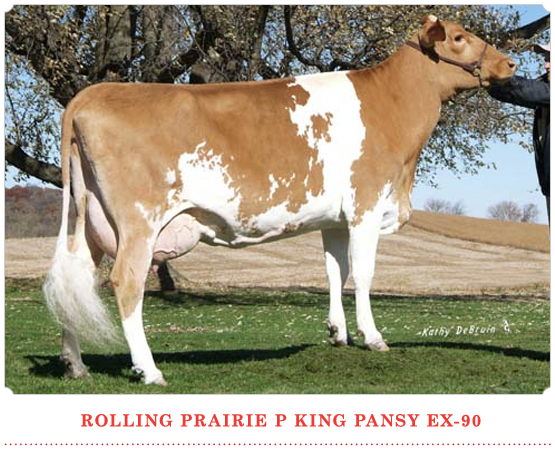Challenge daughters lead Hoard Farm 2-year-olds
 On Monday, March 15, American Guernsey Association executive secretary, Seth Johnson, was at the Hoard's Dairyman Farm to appraise the Hoard Guernsey herd. Scoring began at 6 a.m. and continued during the ensuing day, Johnson evaluated 64 2-year-olds that received their first-ever score. The 64 first-score cows averaged 79.03 for final score, 80.56 on udders, and 80.17 on feet and legs.
On Monday, March 15, American Guernsey Association executive secretary, Seth Johnson, was at the Hoard's Dairyman Farm to appraise the Hoard Guernsey herd. Scoring began at 6 a.m. and continued during the ensuing day, Johnson evaluated 64 2-year-olds that received their first-ever score. The 64 first-score cows averaged 79.03 for final score, 80.56 on udders, and 80.17 on feet and legs.Of those 64 first score cows, there were 11 1GU418 Idle Gold E Challenge-ET daughters that were evaluated for the first time. These moderate-framed cows were 2 years, 9 months of age (on average) on appraisal day and had an 82.2 final score, 83.7 udders, and 81.4 feet and legs. When it comes to production, the 11-cow-Challenge group calved at 2 years, 1 month and have actual 305-day projections of 17,059M 5.2 880F 3.3 571P.
When looking at all cows on the farm, averages included:
• First lactation, 126 cows: 78.9 points, 79.9 udders, and 80.1 feet and legs
• Second lactation, 87 cows: 80.4 points, 79.5 udders, and 81.6 feet and legs
• Third and greater lactation (4.31 lactations), 124 cows: 83.8 points, 82.7 udders, and 83 feet and legs
• All cows, 337 cows: 81.1 points, 80.7 udders, 81.5 feet and legs.
The Hoard Farm had three new Excellent cows including:
• Rutter Bros Goliaths Ruby, EX-90, VG-88 MS, EX-90 F&L. Ruby's has 151,123 M, 8623 F, and 5,370 P of lifetime credits to date. She is due for the tenth time this September. Her dam, Ruthie EX-91 has 194,399 M, 10.130 F, and 7130 P, in her lifetime and counting.
• Lavon Farms Mountains Molly, EX-90 and EX-91 MS. Molly is completing a 8-1 record of 303 days, 20,721 M 4.2 875 F, 3.2 658 P.
• Rolling Prairie P King Pansy (shown above), EX-90, EX-90 MS, and EX-90 F&L. Pansy recently completed a 5-1 record of 365 days, 25,098 M, 4.5 1,120 F, 3.3 and 819 P. She has a Trotacre Enhancer Lewis-ET daughter that is VG-85 in the second lactation. More on Pansy at http://www.hoards.com/farm/favs/Pansy
After reviewing the data, the Hoard Farm ended up with:
• 20 Excellents (90 points or higher)
• 196 Very Goods (80 to 89 points)
• 111 Desirable (70 to 79 points)
• 10 Acceptable (60 to 69 points)
A complete list of appraisal scores can be found by downloading the file below.
Hoard_Farm_Classification.pdf
Labels: Classification, Guernsey, Hoard Farm

